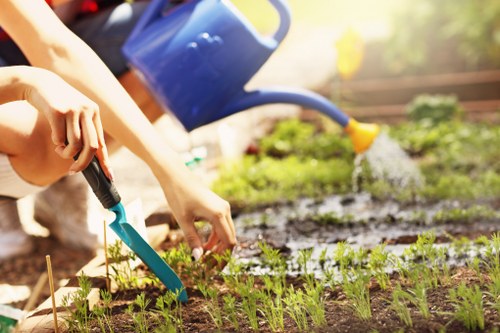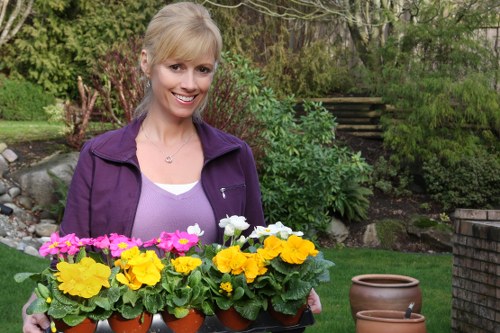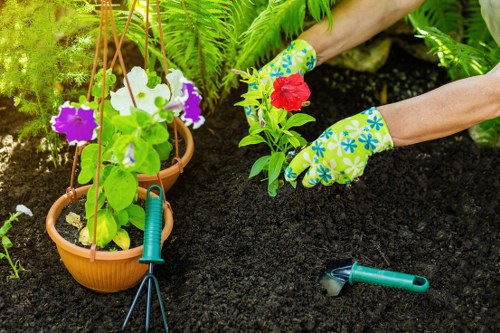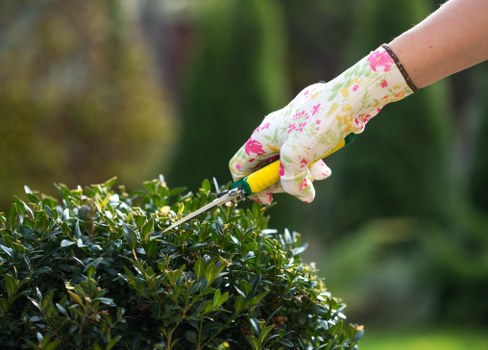Mastering Hedge Trimming in Bow: A Comprehensive Guide
Introduction to Hedge Trimming

Maintaining hedges is essential for both the aesthetics and health of your garden. Hedge trimming in Bow is a specialized skill that ensures your hedges remain lush, well-shaped, and free from diseases. Whether you're a gardening enthusiast or a professional landscaper, understanding the nuances of hedge trimming can significantly enhance the beauty of your outdoor space.
In Bow, the local climate and soil conditions play a crucial role in determining the best practices for hedge trimming. By following the right techniques, you can promote vigorous growth, prevent pest infestations, and achieve the desired shape and size for your hedges.
This guide delves into the various aspects of hedge trimming in Bow, offering insights, tips, and step-by-step instructions to help you achieve optimal results.
Understanding the Importance of Hedge Trimming

Hedge trimming is not just about cutting back overgrown branches; it's a vital maintenance task that serves several purposes:
- Aesthetic Appeal: Well-trimmed hedges add structure and symmetry to your garden, enhancing its overall appearance.
- Health of the Plants: Regular trimming removes dead or diseased branches, promoting healthier growth.
- Control Size and Shape: Trimming helps maintain the desired size and shape of your hedges, preventing them from becoming unruly.
- Improved Air Circulation: Proper trimming ensures better air flow through the hedge, reducing the risk of fungal infections.
In Bow, where seasonal changes are significant, timely hedge trimming can make a substantial difference in the longevity and vitality of your plants.
Moreover, different types of hedges require specific trimming techniques. Understanding the unique needs of each plant species is crucial for effective maintenance.
Tools and Equipment for Hedge Trimming

Equipping yourself with the right tools is the first step towards successful hedge trimming. Here's a list of essential tools you'll need:
- Hedge Trimmers: Electric or manual trimmers are used for cutting the branches to the desired length.
- Pruning Shears: Ideal for precision trimming of smaller branches and shaping the hedge.
- Loppers: Useful for cutting thicker branches that are beyond the reach of pruning shears.
- Safety Gear: Gloves, safety glasses, and ear protection to ensure your safety during the trimming process.
- Ladders: For reaching higher parts of the hedge, especially if it is tall.
Investing in high-quality tools not only makes the trimming process easier but also ensures cleaner cuts, which are less likely to lead to plant diseases.
Regular maintenance and sharpening of your tools will prolong their lifespan and maintain their efficiency.
When to Trim Your Hedges in Bow

Timing is crucial when it comes to hedge trimming. In Bow, the best times to trim your hedges are:
- Late Spring: After the initial growth burst, trimming can help maintain the shape and encourage denser foliage.
- Late Summer or Early Autumn: This is ideal for a final trim before the onset of winter, ensuring that the hedges are well-maintained.
- Avoid Winter: Trimming during the freezing months can damage the plants and make them more susceptible to diseases.
It's important to consider the specific requirements of your hedge species when planning your trimming schedule. Some plants may have unique needs that differ from the general guidelines.
Additionally, avoiding trimming during periods of extreme weather or stress can prevent unnecessary damage to your hedges.
Step-by-Step Guide to Trimming Hedges

1. Preparation
Before you begin trimming, ensure that you have all the necessary tools and safety gear. Inspect your equipment for any damages and make sure they are in good working condition.
2. Assess the Hedge
Examine your hedge to determine which branches need to be trimmed. Look for overgrown, dead, or diseased branches and plan the overall shape you want to achieve.
3. Start Trimming
Begin trimming from the bottom of the hedge, working your way up. This approach helps maintain an even shape and prevents taller branches from overshadowing the lower ones.
4. Shape the Hedge
Use your trimming tools to shape the hedge according to your desired design. Whether you prefer a formal, geometric shape or a more natural look, consistency is key.
5. Clean Up
After trimming, collect all the cut branches and dispose of them properly. This step helps keep your garden neat and reduces the risk of pest infestations.
Regularly stepping through the trimming process will help maintain the health and appearance of your hedges over time.
Remember to always follow safety guidelines to prevent accidents and ensure a smooth trimming experience.
By adhering to these steps, you can achieve beautifully trimmed hedges that enhance the charm of your Bow garden.
Common Mistakes to Avoid
Avoiding common trimming mistakes can save your hedges from unnecessary harm and ensure their optimal growth:
- Over-Trimming: Removing too much foliage can stress the plant and impede its growth.
- Incorrect Timing: Trimming at the wrong time of year can lead to frost damage or inhibit flowering.
- Poor Tool Maintenance: Dull or dirty tools can cause jagged cuts, making plants more susceptible to diseases.
- Ignoring Plant Species: Different hedges have specific trimming needs; failing to recognize these can lead to improper maintenance.
- Skipping Safety Precautions: Neglecting safety gear can result in injuries while trimming.
Being mindful of these errors and taking corrective measures ensures the long-term health and beauty of your hedges.
Educating yourself about the specific requirements of your hedge species can prevent many of these common mistakes.
Benefits of Professional Hedge Trimming Services in Bow
While DIY hedge trimming is feasible, opting for professional services offers several advantages:
- Expertise: Professionals possess the knowledge and experience to handle various hedge types effectively.
- Efficiency: Trimming is done swiftly and accurately, saving you time and effort.
- Tool Access: Professionals have access to high-quality, specialized tools that ensure clean and precise cuts.
- Consistent Results: Achieving a uniform shape and size is easier with professional help.
- Healthier Hedges: Professionals can identify and address issues like diseases or pest infestations during trimming.
In Bow, where garden aesthetics are highly valued, hiring a professional hedge trimming service can significantly enhance the appearance and health of your hedges.
Moreover, professionals can provide valuable advice on hedge care and maintenance tailored to your specific needs.
Environmental Impact of Hedge Trimming
Hedge trimming, when done responsibly, can have a positive environmental impact:
- Promotes Biodiversity: Well-maintained hedges provide habitats for various wildlife species.
- Carbon Sequestration: Healthy hedges absorb carbon dioxide, contributing to carbon sequestration efforts.
- Soil Health: Proper trimming prevents soil erosion and maintains healthy soil structure.
- Water Conservation: Managed hedges require less water and are more resilient to drought conditions.
In Bow, where environmental consciousness is growing, sustainable hedge trimming practices are essential for maintaining ecological balance.
Using eco-friendly tools and methods can further enhance the environmental benefits of your hedge trimming activities.
Seasonal Hedge Trimming Tips
Each season presents unique challenges and opportunities for hedge trimming:
Spring
Early spring trimming stimulates new growth and shapes your hedge for the upcoming growing season.
Summer
Light trimming in summer helps maintain the shape and prevents hedges from becoming too dense.
Autumn
Final trims in autumn prepare your hedges for winter, ensuring they remain healthy through colder months.
Winter
Avoid trimming during winter to prevent damage from frost and cold temperatures.
Year-Round Care
Regular inspections and minor adjustments throughout the year keep your hedges in prime condition.
Adapting your trimming practices to each season ensures your hedges remain vibrant and resilient.
In Bow's dynamic climate, being attuned to seasonal changes is crucial for effective hedge maintenance.
Choosing the Right Hedge Plants
Selecting suitable hedge plants is the foundation of successful hedge trimming:
- Boxwood: Ideal for formal, structured hedges with precise trimming.
- Privet: Fast-growing and versatile, suitable for various shapes and sizes.
- Yew: Durable and evergreen, perfect for long-lasting hedges.
- Laurel: Dense foliage makes it excellent for privacy hedges.
- Holly: Adds a touch of color with its bright berries and spiky leaves.
Understanding the growth habits and trimming requirements of each plant type ensures you choose the right hedge for your Bow garden.
Consulting with local nurseries or gardening experts can provide valuable insights into the best hedge options for your specific needs.
Maintaining Hedge Tools
Proper maintenance of your hedge trimming tools extends their lifespan and ensures effective performance:
- Cleaning: Remove sap, dirt, and debris after each use to prevent rust and corrosion.
- Sharpening: Regularly sharpen blades to ensure clean cuts and reduce plant stress.
- Lubrication: Apply oil to moving parts to maintain smooth operation.
- Storage: Store tools in a dry, protected place to prevent damage from the elements.
- Inspection: Regularly check for any signs of wear or damage and repair or replace parts as needed.
Investing time in tool maintenance pays off by making your trimming tasks more efficient and ensuring the health of your hedges.
Using high-quality tools and maintaining them properly is essential for achieving the best possible trimming results.
Eco-Friendly Trimming Practices
Adopting eco-friendly trimming methods contributes to a sustainable garden:
- Use Manual Tools: Electric or gas-powered trimmers have a lower environmental impact when replaced with manual alternatives.
- Compost Clippings: Instead of disposing of trimmings, compost them to enrich your garden soil.
- Natural Pest Control: Use organic methods to manage pests instead of chemical treatments.
- Water Conservation: Trim hedges in a way that promotes water-efficient growth.
- Protect Wildlife: Maintain natural spaces within your hedges to support local wildlife habitats.
Implementing these practices not only benefits the environment but also enhances the overall health and resilience of your hedges.
In Bow, where environmental sustainability is increasingly important, eco-friendly trimming methods are highly recommended.
Troubleshooting Common Hedge Problems
Even with proper trimming, hedges can encounter various issues:
- Yellowing Leaves: Often a sign of overwatering or poor drainage.
- Sparse Growth: May indicate insufficient sunlight or nutrient deficiencies.
- Pest Infestations: Common pests include aphids, mites, and caterpillars.
- Diseases: Fungal infections like powdery mildew can affect hedge health.
- Dieback: Severe trimming mistakes can lead to branches dying back.
Addressing these problems promptly ensures your hedges remain healthy and vibrant.
Regular inspections and proactive care are essential for preventing and managing these common issues.
Conclusion and Next Steps
Effective hedge trimming in Bow is a blend of knowledge, skill, and the right tools. By understanding the importance of timely and proper trimming, equipping yourself with the necessary tools, and following best practices, you can maintain beautiful and healthy hedges year-round.
Remember to consider the specific needs of your hedge species, avoid common trimming mistakes, and adopt eco-friendly practices to enhance the sustainability of your garden.
For those seeking professional assistance, local hedge trimming services in Bow offer expertise and convenience, ensuring your hedges receive the best possible care.
Contact us today to schedule your hedge trimming service and transform your garden into a stunning landscape.

